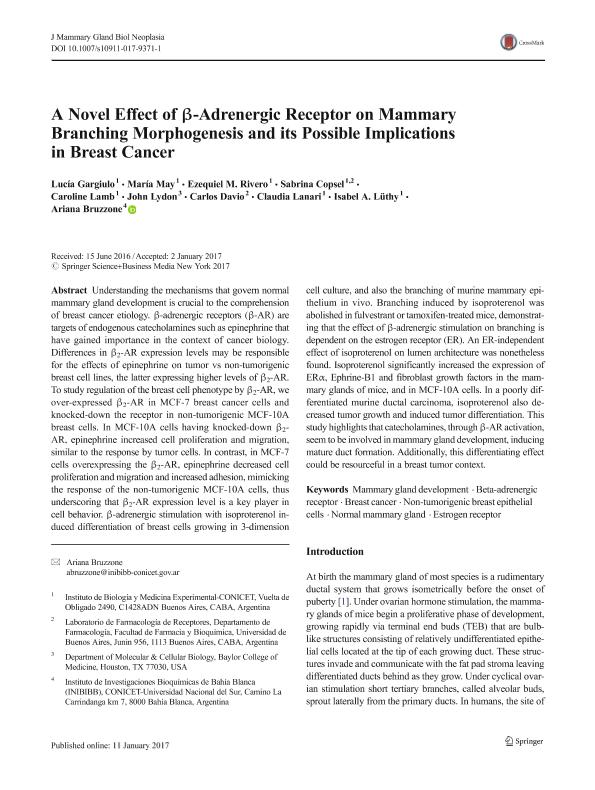Artículo
A Novel Effect of β-Adrenergic Receptor on Mammary Branching Morphogenesis and its Possible Implications in Breast Cancer
Gargiulo, Lucía ; May, María; Rivero, Ezequiel Mariano
; May, María; Rivero, Ezequiel Mariano ; Copsel, Sabrina Natalia
; Copsel, Sabrina Natalia ; Lamb, Caroline Ana
; Lamb, Caroline Ana ; Lydon, John; Davio, Carlos Alberto
; Lydon, John; Davio, Carlos Alberto ; Lanari, Claudia Lee Malvina
; Lanari, Claudia Lee Malvina ; Luthy, Isabel Alicia
; Luthy, Isabel Alicia ; Bruzzone, Ariana
; Bruzzone, Ariana
 ; May, María; Rivero, Ezequiel Mariano
; May, María; Rivero, Ezequiel Mariano ; Copsel, Sabrina Natalia
; Copsel, Sabrina Natalia ; Lamb, Caroline Ana
; Lamb, Caroline Ana ; Lydon, John; Davio, Carlos Alberto
; Lydon, John; Davio, Carlos Alberto ; Lanari, Claudia Lee Malvina
; Lanari, Claudia Lee Malvina ; Luthy, Isabel Alicia
; Luthy, Isabel Alicia ; Bruzzone, Ariana
; Bruzzone, Ariana
Fecha de publicación:
03/2017
Editorial:
Springer/Plenum Publishers
Revista:
Journal of Mammary Gland Biology and Neoplasia
ISSN:
1083-3021
e-ISSN:
1573-7039
Idioma:
Inglés
Tipo de recurso:
Artículo publicado
Clasificación temática:
Resumen
Understanding the mechanisms that govern normal mammary gland development is crucial to the comprehension of breast cancer etiology. β-adrenergic receptors (β-AR) are targets of endogenous catecholamines such as epinephrine that have gained importance in the context of cancer biology. Differences in β2-AR expression levels may be responsible for the effects of epinephrine on tumor vs non-tumorigenic breast cell lines, the latter expressing higher levels of β2-AR. To study regulation of the breast cell phenotype by β2-AR, we over-expressed β2-AR in MCF-7 breast cancer cells and knocked-down the receptor in non-tumorigenic MCF-10A breast cells. In MCF-10A cells having knocked-down β2-AR, epinephrine increased cell proliferation and migration, similar to the response by tumor cells. In contrast, in MCF-7 cells overexpressing the β2-AR, epinephrine decreased cell proliferation and migration and increased adhesion, mimicking the response of the non-tumorigenic MCF-10A cells, thus underscoring that β2-AR expression level is a key player in cell behavior. β-adrenergic stimulation with isoproterenol induced differentiation of breast cells growing in 3-dimension cell culture, and also the branching of murine mammary epithelium in vivo. Branching induced by isoproterenol was abolished in fulvestrant or tamoxifen-treated mice, demonstrating that the effect of β-adrenergic stimulation on branching is dependent on the estrogen receptor (ER). An ER-independent effect of isoproterenol on lumen architecture was nonetheless found. Isoproterenol significantly increased the expression of ERα, Ephrine-B1 and fibroblast growth factors in the mammary glands of mice, and in MCF-10A cells. In a poorly differentiated murine ductal carcinoma, isoproterenol also decreased tumor growth and induced tumor differentiation. This study highlights that catecholamines, through β-AR activation, seem to be involved in mammary gland development, inducing mature duct formation. Additionally, this differentiating effect could be resourceful in a breast tumor context.
Archivos asociados
Licencia
Identificadores
Colecciones
Articulos(IBYME)
Articulos de INST.DE BIOLOGIA Y MEDICINA EXPERIMENTAL (I)
Articulos de INST.DE BIOLOGIA Y MEDICINA EXPERIMENTAL (I)
Articulos(INIBIBB)
Articulos de INST.DE INVEST.BIOQUIMICAS BAHIA BLANCA (I)
Articulos de INST.DE INVEST.BIOQUIMICAS BAHIA BLANCA (I)
Articulos(ININFA)
Articulos de INST.DE INVEST.FARMACOLOGICAS (I)
Articulos de INST.DE INVEST.FARMACOLOGICAS (I)
Citación
Gargiulo, Lucía; May, María; Rivero, Ezequiel Mariano; Copsel, Sabrina Natalia; Lamb, Caroline Ana; et al.; A Novel Effect of β-Adrenergic Receptor on Mammary Branching Morphogenesis and its Possible Implications in Breast Cancer; Springer/Plenum Publishers; Journal of Mammary Gland Biology and Neoplasia; 22; 1; 3-2017; 43-57
Compartir
Altmétricas



